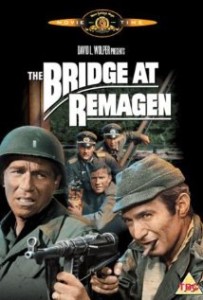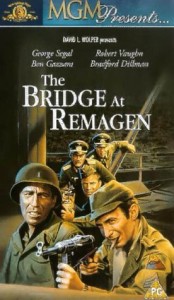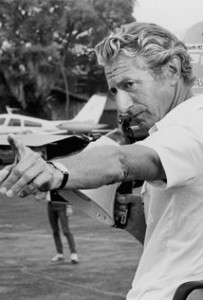The Bridge at Remagen **** (1969, George Segal, Robert Vaughn, Ben Gazzara, Bradford Dillman, E G Marshall, Peter van Eyck) – Classic Movie Review 2,937
The 1969 American Second World War film The Bridge at Remagen is intelligent, effective and exciting old-style film-making. George Segal, Ben Gazzara and Robert Vaughn head a sterling ensemble cast.
Based on a real-life true story, director John Guillermin’s 1969 American DeLuxe Color and Panavision Second World War film The Bridge at Remagen is intelligent, effective and exciting old-style film-making.
The story by Roger Hirson is all about the American Army searching for a bridgehead across the impenetrable River Rhine to launch a major assault into the heart of Germany. This involves them in trying to take over the last Rhine bridge before the Germans blow it up in February 1945. But, as the Allied armies close in, the Nazis decide to blow it up, trapping their own men on the wrong side.
Richard Yates and William Roberts’s screenplay tells the story from both the German and American perspectives. It tries hard to develop its honourable anti-war stance and provides an intelligent look at the Allied and Nazi battle plans, with strong results. And Guillermin’s direction is painstaking and conscientious. But perhaps, most all it is the good cast and the action and stunts (under stunt supervisor Hal Needham) that are what really count.
On the acting front, there is excellent work from George Segal (as Lieutenant Phil Hartman, Robert Vaughn (as Major Paul Kreuger), Ben Gazzara (as Sergeant Angelo), Bradford Dillman (as Major Barnes), E G Marshall (as Brigadier General Shinner), Peter van Eyck (as General Von Brock), heading a sterling ensemble cast.
West Germany would not allow the film to be made there because of shipping traffic on the Rhine, so The Bridge at Remagen became the first American film to be shot in Communist Czechoslovakia. It was filmed in Czechoslovakia in difficult circumstances just as the Russians marched in to the country, but cinematographer Stanley Cortez still manages to secure spectacular colour footage. And Elmer Bernstein’s score is another powerful asset, along with Alfred Sweeney’s production designs.
Filming started on 6 June 1968, but on 20 August 1968, when the film was two-thirds complete, the Soviet Army invaded Czechoslovakia, Filming resumed in Hamburg, West Germany, with ideal studio facilities in October 1968. Unfinished scenes involving the bridge were shot in Italy at Castel Gandolfo, southeast of Rome. Producer David L Wolper also negotiated filming of the blowing up of the bridge in Prague. Wolper recalled: The actors get on the bridge in Czechoslovakia, remove explosive under the bridge in Germany and get off the bridge in Italy.’
Also in the cast are Matt Clark, Fritz Ford, Tom Heaton, Bo Hopkins, Robert Logan, Paul Prokop, Steve Sandor, Frank Webb, Hans Christian Blech, Joachim Hansen and Günther Mesiner.
It is based on the non-fiction book The Bridge at Remagen: The Amazing Story of March 7, 1945 by the writer and US Congress Representative Ken Hechler. The film’s script is a considerably fictionalised version of the events at the end of World War Two when the US 9th Armored Division approached Remagen and captured the intact Ludendorff Bridge. The main characters based on real people, sometimes only loosely, with the names changed.
Ken Hechler was a war historian serving in the US Army in 1945. He recalled: ‘I was lucky to be about 10 miles from Remagen when the electrifying news came down that the bridge had been captured. We had just liberated this wine cellar. The first units came back and were sent into reserve, and had nothing to do but drink wine and talk about what they had done.’
Those interviews and later ones with German soldiers at the bridge form most of Hechler’s book, published in 1957. It sold more than 500,000 copies, but Hechler got only $5,000 for the film rights. He recalled: ‘They told me if I held out for more money, they’d change the name from The Bridge at Remagen to The Remagen Bridge and base it on newspaper accounts.’
The actual bridge at Remagen was not rebuilt, and the towers on each bank have become a museum and arts studios.
The cast are George Segal as Lieutenant Phil Hartman, Robert Vaughn as Major Paul Kreuger, Ben Gazzara as Sergeant Angelo, Bradford Dillman as Major Barnes, E G Marshall as General Shinner, Peter Van Eyck as Generaloberst Von Brock, Hans Christian Blech as Hauptmann Karl Schmidt, Heinz Reincke as the mayor Councillor Holzgang, Joachim Hansen as Hauptmann engineering officer Otto Baumann, Sonja Ziemann as Greta Holzgang, Anna Gael as French Girl, Bo Hopkins as Corporal Grebs, Robert Logan as Private Bissell, Matt Clark as Corporal Jellicoe, Steve Sandor as Private Slavek, Frank Webb as Private Glover, Tom Heaton as Lieutenant Pattison, Paul Prokop as Captain John Colt, Richard Münch as General Von Sturmer, and Günter Meisner as SS-Obergruppenführer Gerlach.
Hal Needham, long-time stuntman and director of Smokey and the Bandit and The Cannonball Run for Burt Reynolds, died in Los Angeles of cancer on 25 October 2013, aged 82. He worked as a stuntman on How the West Was Won, The Bridge at Remagen, McLintock! and Little Big Man.
British film-maker John Guillermin, director of The Towering Inferno, the 1976 King Kong, Death on the Nile, The Blue Max, and The Bridge at Remagen died on 28 September 2015, aged 89. He was best known for big-budget action films, also including El Condor, Shaft in Africa, Sheena and the Kong sequel King Kong Lives. He said: There’s really nothing like an exciting film on a big screen. Hopefully, I’ve made a few in my career.’
© Derek Winnert 2015 Classic Movie Review 2,937
Check out more reviews on http://derekwinnert.com









